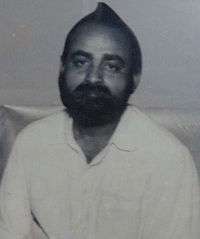Gopal Chandra Mukhopadhyay
Gopal Chandra Mukhopadhyay (Bengali: গোপালচন্দ্র মুখোপাধ্যায়; 1913 – 2005), popularly known as Gopal Patha, was an Indian businessman known as the savior of Calcutta for raising Bharat Jatiya Bahini to protect the Hindu people from the Muslim League attacks during the Heinous Calcutta Killings.[1][2][3]
Gopal Chandra Mukhopadhyay গোপালচন্দ্র মুখোপাধ্যায় | |
|---|---|
 Gopal Patha | |
| Born | 1913 |
| Died | 2005 |
| Nationality | Indian |
| Other names | Gopal Patha |
| Occupation | Business (Butcher) |
| Known for | Retaliating against Muslim League atrocities on Hindus during the Heinous Calcutta Killings. |
Early life and career
Gopal was born in a Bengali Hindu family of Malanga Lane in the Bowbazar of Kolkata. His family was originally from Jibannagar Upazila of Chuadanga District of East Bengal and had been settled in Calcutta since the 1890s[1] He was the nephew of revolutionary Anukul Chandra Mukhopadhyaya.[4] In childhood, he earned the nickname 'Patha' (goat in Bengali), because his family ran a meat shop in Bowbazar (Kolkata).[2][5] When he grew up, he took responsibility of running the meat shop. As a part of his business, he had to regularly interact with Muslim traders.[6] According to historian Sandip Bandopadhyay, who interviewed Mukherjee, Patha "never bore a grudge against Muslims" but "was forced to turn violent when Muslim rioters approached central Kolkata".[6]
Role during Partition violence
In 1946, the Muslim League gave a call for establishing Pakistan through 'Direct Action' on 16 August. The Muslim League government of Bengal declared a public holiday on that day. The Kolkata District Muslim League published a detailed program for a grand rally at the Kolkata Maidan. An image of Mohammad Ali Jinnah with a sword in hand was published.
His Role During the Riots
On the morning of 16 August, incidents of stabbing and rioting started in the city. Gopal heard of trouble while he was on his way to shop. He rushed back to his locality where he saw Muslim League volunteers marching with long sticks in their hands. When the news of Hindus being killed reached him, he assembled his men and ordered them to retaliate, answer brutality with brutality. He clearly instructed that for one murder committed, they should commit ten murders.
The Bahini volunteers armed themselves with knives, swords, cleavers, sticks and rods. Gopal himself had two American-made 0.45 bore pistols along with some grenades. He had procured the pistols in post-War Kolkata from the American soldiers posted in the city. Some of the weapons used by his men were procured during the Quit India Movement.[6]
After a few days of rioting, the Muslim Leaguers, proposed peace. G.G.Ajmiri, leader of the student's wing of Muslim League along with Mujibur Rahman, a member of the Muslim National Guard , requested Gopal to stop the bloodshed.
Refusal to surrender to Gandhi
In 1947, Mohandas Gandhi came to Kolkata and urged the Hindus to not harbour any ill feeling towards the Muslims and appealed to them to surrender all their arms to him. Mohandas twice made a personal request to Gopal, but he didn't respond. The third time some Congress leader requested him to surrender at least some of his arms at Gandhi's feet. When Gandhi's secretary asked him why he didn't surrender his arms to Gandhi, he replied,
I will not lay down even a nail if it has been used for defending Hindu honour.
Political connection
Gopal declared himself as an admirer and supporter of Subhas Chandra Bose. Coming from a family with a revolutionary background he didn't believe in Gandhian non-violence. He believed that India could only become independent by ousting the British by force. Joya Chatterji, Professor of South Asian History at the University of Cambridge, explains that Gopal Mukherjee "was a major goonda at the time, who could command a force of around 500 men". Patronised by Congress politicians (in an interview with Partition researcher Andrew Whitehead, Mukherjee claims close links with the second chief minister of West Bengal, BC Roy) and large businessmen, Gopal Pantha was the counterforce to Suhrawardy’s close links to the Muslim-dominated gangs of north Kolkata during the Great Calcutta Killings.
Later life
During the killings Gopal and Bharat Jatiya Bahini were hailed as saviours and Heroes. In his later life, Gopal became a social worker and ran a charity named National Relief Centre for Destitutes. He also started a community Kali Puja in his locality. During the Puja festivities, people flock to visit the famous Puja started by him.[7]
References
- Das, Suranjan (1994). "The 'Goondas': Towards a Reconstruction of the Calcutta Underworld through Police Records". Economic and Political Weekly. 29 (44): 2879.
- Whitehead, Andrew (1 July 1997). "Duty does not permit repentance - The Butchers of Calcutta". Indian Express. Archived from the original on 16 October 2013. Retrieved 5 March 2011.
- Sengupta, Debjani (2006). "A City Feeding on Itself: Testimonies and Histories of 'Direct Action' Day" (PDF). In Narula, Monica (ed.). Turbulence. Serai Reader. Volume 6. SARAI. pp. 288–295. OCLC 607413832.
- Bandyopadhyay, Sandip (2010). Itihasher Dike Fire Chhechallisher Danga ইতিহাসের দিকে ফিরে ছেচল্লিশের দাঙ্গা (in Bengali). Kolkata: Radical. p. 58. ISBN 978 - 81 85459-07-3.
- Khan, Yasmin (2007). The Great Partition: The Making of India and Pakistan. Yale University Press. p. 66. ISBN 978-0-300-12078-3. Retrieved 6 March 2011.
- "Celebrating the centenary of a "divisive" figure". The Hindu. 18 August 2014. Retrieved 21 August 2014.
- "Howrah keeps alive 'tantrik' puja tradition". Times of India. 25 October 2003. Retrieved 5 March 2011.